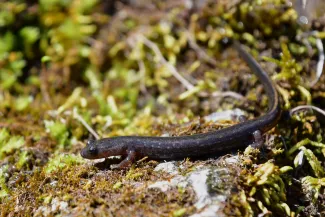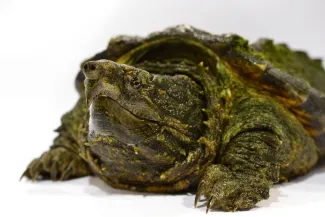The State Wildlife Grant Program provide money to states, territories, commonwealths, and D.C. to address wildlife conservation needs such as research, surveys and species and habitat management. Projects focus on wildlife species of greatest conservation need identified in State Wildlife Action Plans.
On July 6, 2022, this post appeared on the Oklahoma Department of Wildlife Conservation’s social media feeds: ”Don’t mind us – we’re just sliding into your feed to let you know the Wildlife Department has kicked off two alligator research projects at Red Slough Wildlife Management Area with our partners at Southeastern Oklahoma State University and Southwestern Adventist University. For the next two years, we’ll be studying the native population, tracking individuals, and developing a long-term management plan for the species. Courtesy Jared Wood, Southwestern Adventist University.
The Wildlife Department made a splash this summer when it announced on social media the launch of two of its latest research and survey grants, focused on the small alligator population in and around Red Slough Wildlife Management Area. The landmark work will provide the Department with its first official assessments of the state’s alligator population. It also marks a 20-year milestone in the agency’s considerable history of conserving Oklahoma’s fish and wildlife.
“The Wildlife Department has a rich heritage of conservation, but we haven’t always had a dedicated funding source for conserving or assessing the state’s alligator population or other species that aren’t hunted or fished,” said Kurt Kuklinski, research supervisor for the Wildlife Department. “That type of committed funding has only been available for the last 20 years.”
States have traditionally funded conservation by way of federal Wildlife and Sport Fish Restoration Program grants that originated with the popular Pittman–Robertson Act of 1937 and the Dingell–Johnson Act of 1950. These measures established a funding model that pairs hunting and fishing license sales with excise taxes on certain sporting equipment to help pay for conservation of wild birds, mammals, fish, and their habitats.
Species other than birds, mammals, and fish have indirectly benefited from work underwritten by the Wildlife and Sport Fish Restoration Program for decades but weren’t the focus of a direct funding program until the early 2000s, when the State Wildlife Grant Program was approved by Congress. This relatively new program provides federal reimbursement grants, distributed by the U.S. Fish and Wildlife Service, to state fish and wildlife agencies to enhance species in greatest need of additional conservation attention.
To be eligible for the funding, the Wildlife Department created a comprehensive wildlife conservation strategy that identifies more than 300 species of greatest conservation need, including not only the traditional birds, mammals, and fish, but also amphibians, reptiles, and invertebrates. Nearly half of the species approved for State Wildlife Grant Program funding in Oklahoma could not be directly addressed by the earlier grant program.

A state wildlife grant project funded in 2011, led by the University of Tulsa, focused in part on the distribution and diversity of Oklahoma salamanders. The resulting surveys were paired with work conducted in Missouri and led to the withdrawal of a petition to federally list the species as threatened or endangered.
“The State Wildlife Grant Program is dedicated to collecting data and lets us focus on the state’s species of greatest conservation need,” Kuklinski said. “We can now fund surveys that collect those species’ distribution and range information as well as population stability information.”
These survey-based assessments not only help the Wildlife Department in its conservation mission but come with an added benefit: providing data to the U.S. Fish and Wildlife Service during its species status assessments, especially when the federal agency has been petitioned to add protections for a species through the Endangered Species Act.
“When a species has been petitioned for listing, the U.S. Fish and Wildlife Service looks to state agencies during the status assessment process. A lot of times now, because of work funded by the State Wildlife Grant Program, we’re able to provide the information and data collected in Oklahoma, and the Service can make an informed decision.”
Twenty Years of Nongame Conservation at a Glance: Planning, Partnerships … and So Many Surveys
When the Wildlife Department received its first round of State Wildlife Grant Program funding in 2002, it activated its network of conservation-minded partners to help identify the state’s species of greatest conservation need and outline actions that could benefit those species. Twenty years later, more than 100 grants have been completed, spanning conservation planning efforts, the purchase of habitat to enhance wildlife populations, and species assessments like the American alligator projects that launched earlier this year.
In fact, more than half of the completed grants have focused on species or community-based assessments. These surveys have illuminated the cave life found in northeastern Oklahoma, tallied the mammal communities found on western Wildlife Management Areas, and mapped winter bird occurrences across the state. While most projects are limited to a two- to four-year funding period, others spark a series of projects that more fully implement the state’s conservation plan.

An early state wildlife grant project, funded in 2003 and led by Oklahoma State University, inspired a series of additional alligator snapping turtle projects that resulted in the reintroduction of the species into several watersheds by the Tishomingo National Fish Hatchery with support by Missouri State University.
“Grants often build upon earlier work,” said Mark Howery, senior wildlife biologist who was instrumental in shaping Oklahoma’s State Wildlife Grant Program. “A prime example is a project that looked at the genetic variation among populations of alligator snapping turtles.
“We learned these turtles aren’t very genetically diverse, which means biologists can responsibly take an alligator snapping turtle whose parents came from the Arkansas River watershed and release it in the Red River watershed because the two populations are so genetically similar. This project has been foundational for the reintroduction work now occurring at the Tishomingo National Wildlife Refuge.”
The planning efforts necessary for identifying survey and research needs have similarly inspired long-term conservation work.
“Planning grants can provide the information needed to move project-level funding into program-level funding,” Howery said. “For example, a paddlefish research project, along with other work funded by the Sport Fish Restoration Program, led to the development of the Wildlife Department’s current paddlefish program.
“And a planning-oriented grant was used to help start the Oaks and Prairies Joint Venture. They now have a grassland enhancement program that will pay landowners to implement prescribed burning and other practices to diversify grasslands.”
The Wildlife Department has also used State Wildlife Grant Program funding to buy six parcels of land, totaling more than 18,000 acres. Two of the larger properties became Wildlife Management Areas, Cimmaron Bluff and Cross Timbers, while the other purchases added inholdings and adjacent lands to the existing Beaver River, Cimmaron Hills, and Cookson WMAs. Each property is managed for wildlife, while also offering hunting or fishing opportunities.
“Land acquisitions have the potential to benefit a lot of species – in some cases, entire communities – at one time,” Howery said. “And the Wildlife Department makes these purchases in perpetuity, which can protect the land from any kind of future conversion.
“It comes with a lot of responsibility on our part and sets the platform for future work.”
That future work will be driven by the same passion to conserve Oklahoma’s species of greatest conservation need that has fueled the state’s nongame conservation work for the past two decades. And it will depend on the extensive network of conservation partners that has been instrumental in the funding program’s first 20 years.
“Something like 75 percent of our projects are coordinated with outside partners,” Kuklinski said. “Research partners have come from major universities like Oklahoma State University or the University of Oklahoma, but the expertise needed for some projects has also been found at smaller regional universities.
“The depth of our partnerships – at least 17 grant partners over the course of 20 years – tells me the Wildlife Department is open to ideas coming from a variety of sources.”
Howery said, “The State Wildlife Grant Program and our many partnerships have really helped the Wildlife Department expand nongame conservation in the state. We know there’s a lot of work left to do. Still, we know considerably more about our species of greatest conservation need than we did 20 years ago.”
Find final reports of surveys and research funded by the State Wildlife Grants Program at wildlifedepartment.com. Project updates are also regularly shared in the monthly Wild Side e-newsletter. Subscribe here.
